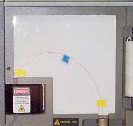Archival Notice
This is an archive page that is no longer being updated. It may contain outdated information and links may no longer function as originally intended.
Home | Glossary | Resources | Help | Contact Us | Course Map
To minimize the formation of DNA secondary structures or intrastrand hybrid structures that impact DNA separation, electrophoretic separation of short tandem repeat (STR) fragments is performed at a temperature of 60°C (Butler 2004). The ABI Prism® capillary electrophoresis (CE) instruments have a heated plate to maintain the temperature of the capillary. On ABI Prism® 310 Genetic Analyzers, the capillary at the inlet and outlet ends are not directly in contact with the heat plate. It is important to maintain room temperature within a few degrees, because fluctuations in room temperature can cause variability in the runs. The newer CE instruments have improved temperature control preventing room temperature fluctuation being a significant issue.
Additional Online Courses
- What Every First Responding Officer Should Know About DNA Evidence
- Collecting DNA Evidence at Property Crime Scenes
- DNA – A Prosecutor’s Practice Notebook
- Crime Scene and DNA Basics
- Laboratory Safety Programs
- DNA Amplification
- Population Genetics and Statistics
- Non-STR DNA Markers: SNPs, Y-STRs, LCN and mtDNA
- Firearms Examiner Training
- Forensic DNA Education for Law Enforcement Decisionmakers
- What Every Investigator and Evidence Technician Should Know About DNA Evidence
- Principles of Forensic DNA for Officers of the Court
- Law 101: Legal Guide for the Forensic Expert
- Laboratory Orientation and Testing of Body Fluids and Tissues
- DNA Extraction and Quantitation
- STR Data Analysis and Interpretation
- Communication Skills, Report Writing, and Courtroom Testimony
- Español for Law Enforcement
- Amplified DNA Product Separation for Forensic Analysts


